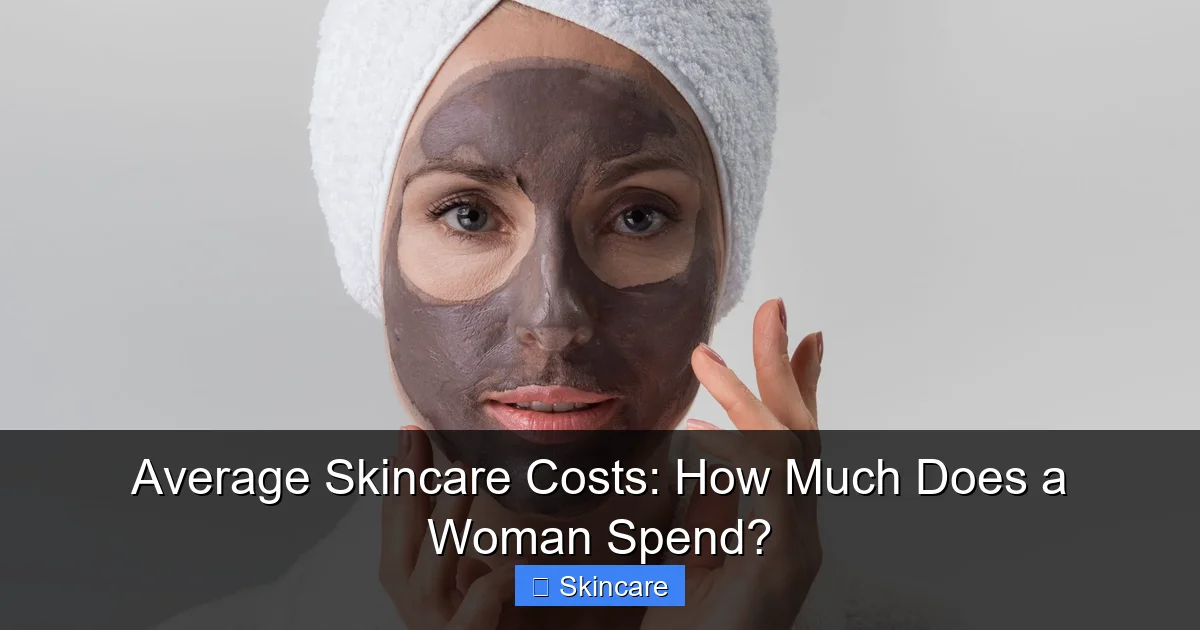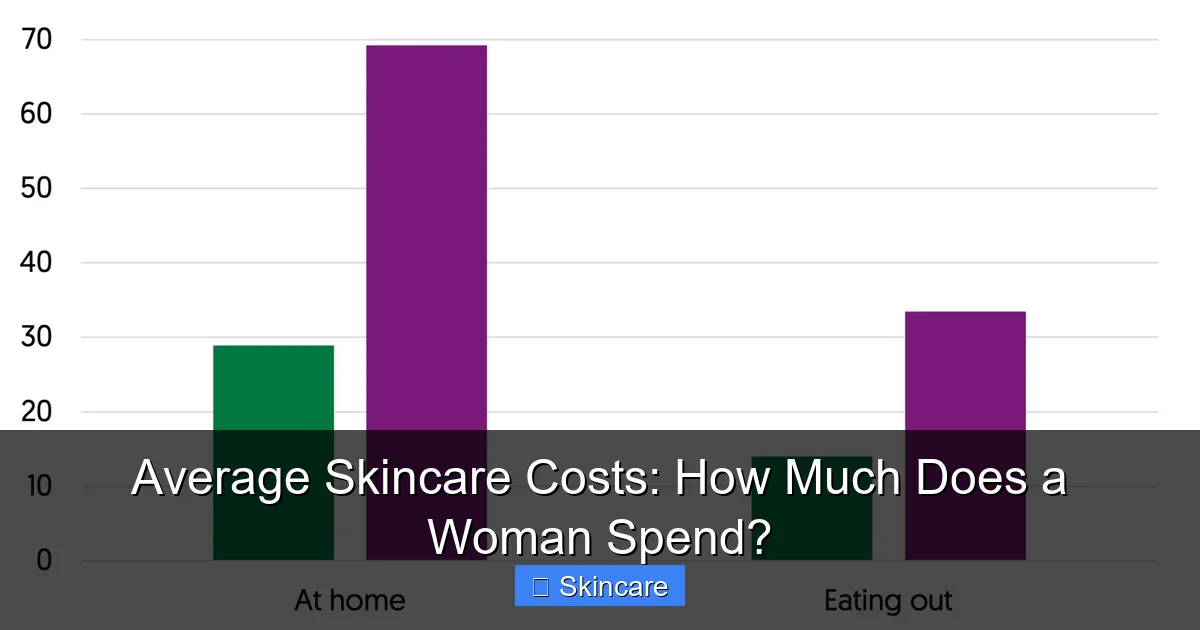
Featured image for this comprehensive guide about how much does the average woman spend on skincare products
Image source: cdn.mos.cms.futurecdn.net
Ever found yourself staring at your bathroom counter, wondering if your growing collection of serums, cleansers, and moisturizers is normal? You’re not alone! Many women ponder the same question: how much does the average woman spend on skincare products? It’s a common query that often leads to a rabbit hole of online searches, comparing routines, and perhaps a touch of skincare envy. Understanding the financial commitment to healthy, glowing skin can be enlightening, whether you’re a minimalist or a multi-step routine enthusiast.
The truth is, there’s no single, one-size-fits-all answer. Skincare spending is as unique as your skin type, influenced by a myriad of factors from lifestyle and age to product preferences and budget. However, we can explore the general trends, break down the costs, and provide some insights into what influences these numbers. So, let’s peel back the layers and uncover the real story behind average skincare costs for women.
📋 Table of Contents
- The Elusive “Average”: What Influences Skincare Spending?
- Breaking Down the Skincare Budget: Product Categories and Costs
- Generational & Lifestyle Differences in Skincare Spending
- The Skincare Spectrum: Drugstore vs. Department Store vs. High-End
- Estimated Annual Skincare Spend Ranges
- Maximizing Your Skincare Investment: Smart Spending Tips
- What Does It All Mean for Your Wallet?
The Elusive “Average”: What Influences Skincare Spending?
When we talk about how much does the average woman spend on skincare products, it’s important to acknowledge that “average” is a very broad term. Several key factors play a significant role in shaping individual skincare budgets and the overall market trends.
Skin Concerns and Goals
- Specific Issues: Women dealing with chronic acne, severe dryness, hyperpigmentation, or sensitive skin often invest more in targeted treatments, dermatological consultations, and prescription-strength products.
- Anti-Aging: Those focusing on anti-aging solutions might spend more on ingredients like retinoids, peptides, and advanced serums designed to reduce fine lines and wrinkles.
- Maintenance: For women primarily focused on maintaining healthy, balanced skin, a simpler and often less expensive routine may suffice.
Age and Life Stage
Skincare needs evolve with age. Teenagers might focus on acne treatments, while women in their 20s and 30s often start incorporating preventative anti-aging products. Later in life, concerns shift towards hydration, collagen support, and addressing mature skin issues, often leading to more specialized and potentially pricier products.
| Spending Metric / Category | Average Spending (USD) | Key Considerations |
|---|---|---|
| Monthly (Basic Routine) | $50 – $100 | Includes cleanser, moisturizer, SPF, and 1-2 active ingredients. Focus on drugstore/mid-range brands. |
| Monthly (Comprehensive Routine) | $100 – $250 | Expands to include serums, eye creams, masks, and mid-to-high-end brands. |
| Annual (Overall Average) | $600 – $1,200 | Reflects regular replenishment, seasonal purchases, and occasional splurges. |
| Cost Per Product (Average) | $20 – $60 | Varies significantly by product type (e.g., cleanser vs. serum) and brand tier (drugstore vs. luxury). |
| Lifetime Spending (Estimate) | $30,000 – $50,000+ | Calculated over 40-50 years of adult life, highly dependent on individual habits, income, and evolving trends. |
Lifestyle and Environment
Your lifestyle directly impacts your skin’s health and, consequently, your skincare budget. Regular sun exposure, pollution, stress, and diet can all necessitate different types of products, from stronger sunscreens to antioxidant serums.
Product Preferences and Brand Loyalty
Some women prefer to stick to drugstore staples, while others gravitate towards luxury brands or medical-grade skincare. Brand loyalty, whether driven by efficacy, ethics, or prestige, can significantly influence the cost of skincare routine.
Breaking Down the Skincare Budget: Product Categories and Costs
To understand how much does the average woman spend on skincare products, it helps to categorize the typical items found in a routine. Each category comes with its own price range, contributing to the overall skincare budget.

Learn more about how much does the average woman spend on skincare products – Average Skincare Costs: How Much Does a Woman Spend?
Image source: moneynerd.co.uk
Cleansers
Foundation of any routine. Options range from basic drugstore brands (e.g., Cetaphil, CeraVe) costing $5-$15, to mid-range options ($20-$40), and luxury or specialized cleansers ($50+).
Toners & Essences
Often seen as optional but beneficial, these can range from $10-$30 for drugstore/affordable options to $40-$100+ for high-end or K-beauty essences.
Serums & Treatments
This is where costs can really climb. Targeted serums for issues like vitamin C, hyaluronic acid, retinol, or niacinamide can range from $20 for budget-friendly options to $50-$150 for mid-range, and upwards of $200-$300+ for luxury or highly concentrated formulations.
Moisturizers
Essential for hydration and barrier support. Prices are similar to cleansers, with budget options at $10-$25, mid-range at $30-$70, and luxury creams easily exceeding $80-$150+.
Sunscreen (SPF)
Non-negotiable for skin health. Daily use is crucial. Most good facial sunscreens range from $15-$40, with some specialized or tinted versions going higher.
Eye Creams
A smaller, targeted product. While some argue they aren’t always necessary if your face moisturizer is adequate, many prefer dedicated eye creams. These typically cost $25-$75, with luxury options soaring past $100.
Masks & Exfoliants
Used periodically, these can add to the intermittent spend. Budget options are $10-$20, while effective mid-range or professional-grade products can be $30-$80+.
Generational & Lifestyle Differences in Skincare Spending
While the “average” is hard to pinpoint, different demographics tend to have varying approaches to their skincare spending habits.

Learn more about how much does the average woman spend on skincare products – Average Skincare Costs: How Much Does a Woman Spend?
Image source: thumbs.dreamstime.com
Gen Z & Millennials
This demographic often shows a strong interest in “clean beauty,” ethical brands, and active ingredients. They are highly influenced by social media and tend to be savvy researchers, often mixing and matching drugstore with a few mid-range “hero” products. Their monthly spend might range from $30-$80, but can spike with new product trends.
Gen X
Often focused on preventative and corrective anti-aging, Gen X consumers might be more willing to invest in established, effective brands and higher-concentration active ingredients. They may also be more inclined towards professional treatments. Their monthly spend could be $50-$150+.
Baby Boomers
With mature skin concerns often prioritized, this group may invest in medical-grade products, hydrating formulas, and treatments aimed at addressing dryness, elasticity, and age spots. They might spend $70-$200+ monthly, including professional services.
The Skincare Spectrum: Drugstore vs. Department Store vs. High-End
The choice of where to buy your products significantly impacts how much does the average woman spend on skincare products. Each tier offers different price points and perceived value.
Drugstore/Mass Market Skincare
- Cost: Typically $5-$25 per product.
- Pros: Highly accessible, budget-friendly, many effective formulations recommended by dermatologists. Brands like CeraVe, La Roche-Posay, The Ordinary, and Neutrogena offer great value.
- Cons: Packaging might not be as luxurious; fewer “novel” or experimental ingredients.
Mid-Range/Department Store Skincare
- Cost: Generally $25-$75 per product.
- Pros: A step up in texture, sensorial experience, and often includes more specialized ingredients. Widely available at beauty retailers (Sephora, Ulta) and department stores. Examples include Clinique, Paula’s Choice, Kiehl’s.
- Cons: Can add up quickly; not always a significant jump in efficacy over drugstore options for basic needs.
Luxury/High-End Skincare
- Cost: $75-$500+ per product.
- Pros: Exquisite textures, sophisticated formulations, unique ingredients, luxurious packaging, and often a strong brand heritage. Brands like La Mer, SK-II, Augustinus Bader.
- Cons: Very expensive; diminishing returns on efficacy past a certain price point; often more about the experience than purely scientific superiority.
Estimated Annual Skincare Spend Ranges
Considering all these factors, here’s a general idea of what average skincare costs might look like on an annual basis for women:
- Minimalist Routine (Cleanser, Moisturizer, SPF): $150 – $400 per year
- Moderate Routine (Cleanser, Toner, Serum, Moisturizer, SPF): $400 – $1,000 per year
- Extensive Routine (Multiple Cleansers, Toner, Several Serums, Eye Cream, Moisturizer, SPF, Masks/Exfoliants): $1,000 – $2,500+ per year
These figures are rough estimates and can fluctuate greatly depending on brand choices, frequency of purchase, and whether professional treatments (facials, peels) are included. On average, studies often suggest women spend anywhere from $50-$150 per month on skincare, translating to $600-$1,800 annually, with a significant portion opting for the mid-to-high end of this range for a more comprehensive routine.
Maximizing Your Skincare Investment: Smart Spending Tips
Regardless of how much does the average woman spend on skincare products, everyone wants to get the most bang for their buck. Here are some actionable tips to optimize your skincare budget:
- Prioritize Core Products: Focus your investment on essentials like a good cleanser, a broad-spectrum SPF, and a targeted serum (e.g., Vitamin C or Retinol) that addresses your primary concern.
- Read Reviews & Do Your Research: Don’t just buy based on hype. Look for evidence-based ingredients and products with consistent positive reviews from people with similar skin types.
- Shop Smarter:
- Sales & Promotions: Stock up during major sales events (Black Friday, seasonal sales).
- Loyalty Programs: Join loyalty programs at your favorite retailers to earn points and discounts.
- Dupe Hunting: Sometimes, a less expensive “dupe” (duplicate) can offer similar active ingredients to a high-end product.
- Consider Cost Per Use: A more expensive product might last longer or be more effective, making its cost per use lower than a cheaper product you go through quickly or that doesn’t deliver results.
- Patch Test & Be Patient: Avoid buying a full regimen at once. Introduce new products one by one to see how your skin reacts. Give products time (4-6 weeks) to show results before discarding them.
- Samples are Your Friend: Ask for samples at beauty counters to try before you buy, especially for pricier items.
- Less Can Be More: A simple, consistent routine with a few effective products is often better than a 10-step routine with mediocre products or too many conflicting active ingredients.
What Does It All Mean for Your Wallet?
Ultimately, the question of how much does the average woman spend on skincare products reveals a wide spectrum rather than a single number. From the diligent budget shopper to the luxury skincare connoisseur, spending habits are deeply personal and dictated by individual needs, desires, and financial capacity. What truly matters isn’t the “average,” but rather what works for *your* skin and *your* budget.
Your skincare journey is an investment in your skin’s health and your confidence. By understanding the factors that influence costs, prioritizing your needs, and shopping smartly, you can build an effective routine that delivers results without breaking the bank. So, whether your monthly skincare budget is $20 or $200, remember that consistency and informed choices are your best assets for achieving healthy, radiant skin.
🎥 Related Video: How much product to use | dermatologist
📺 Dr. Aanchal MD
Using the correct amount of product is important. Using less would make it ineffective and using more would be wasteful or …
Frequently Asked Questions
How much does the average woman spend on skincare products annually?
Estimates vary widely, but many studies suggest the average woman spends between $200 and $700 annually on skincare products. This figure can fluctuate significantly based on individual habits, product choices, and geographical location.
What factors influence how much an average woman spends on skincare?
Several factors impact skincare spending, including age, specific skin concerns (like acne or anti-aging), brand preference, and product type. Choosing high-end brands, specialized treatments, or having a complex routine typically increases the total cost for an average woman.
Is there a typical monthly budget for what women spend on skincare?
While an annual average can be broken down monthly, most women don’t spend a consistent amount every single month. Instead, purchases like serums or moisturizers might be made every few months, leading to fluctuating monthly expenditures rather than a fixed budget.
Which types of skincare products account for the largest portion of an average woman’s spending?
Serums, specialized treatments (like retinol or vitamin C), and high-quality moisturizers often represent the largest portion of skincare spending. Cleansers and toners tend to be more affordable staples and are replaced more frequently, but their individual cost is lower.
Can an average woman achieve good results without spending a lot on skincare products?
Absolutely. Effective skincare doesn’t always equate to expensive products; many affordable drugstore brands offer excellent formulations with beneficial ingredients. Focusing on core essentials like cleanser, moisturizer, and SPF can yield great results for the average woman.
How frequently does the average woman replenish her skincare products?
The frequency of replenishment varies by product type and usage habits. Cleansers and moisturizers might be repurchased every 1-3 months, while serums or specialized treatments could last 3-6 months or even longer, depending on the product size and recommended usage.
